

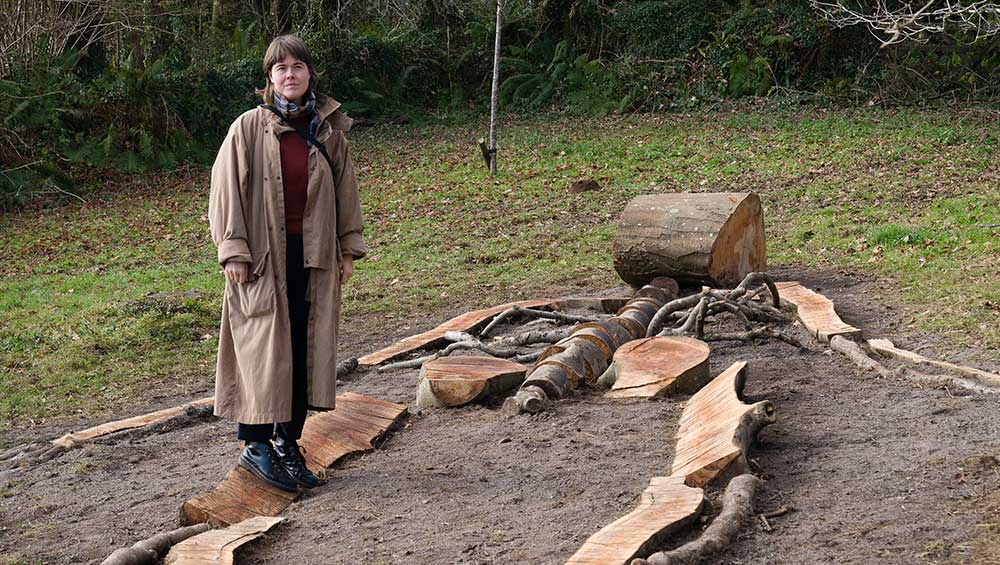
Ingela Ihrman at the Eden Project, Cornwall. Photo: Steve Tanner.
by VERONICA SIMPSON
The Swedish naturalist Jan Lindblad (1932-87) was once “violently embraced in the coils of a giant anaconda” while filming a documentary, we are told at the start of Ingela Ihrman’s new solo show – her first in the UK - called Nocturne, at Gasworks in London. It is a fact we need to understand the first film on show, which draws us (and Lindblad) deep down inside a large, red, pulsating snake-like organism, as she imagines Lindblad might have been (but wasn’t, thankfully) in his determination to get up close and personal with the natural world. She called the work Green Paradise – What Jan Lindblad Would Have Seen from the Inside of the Anaconda (2009), and has even created a costume, an anatomically intriguing representation of Lindblad’s digested entrails, which you can choose to wear (or not) as you proceed through the show.
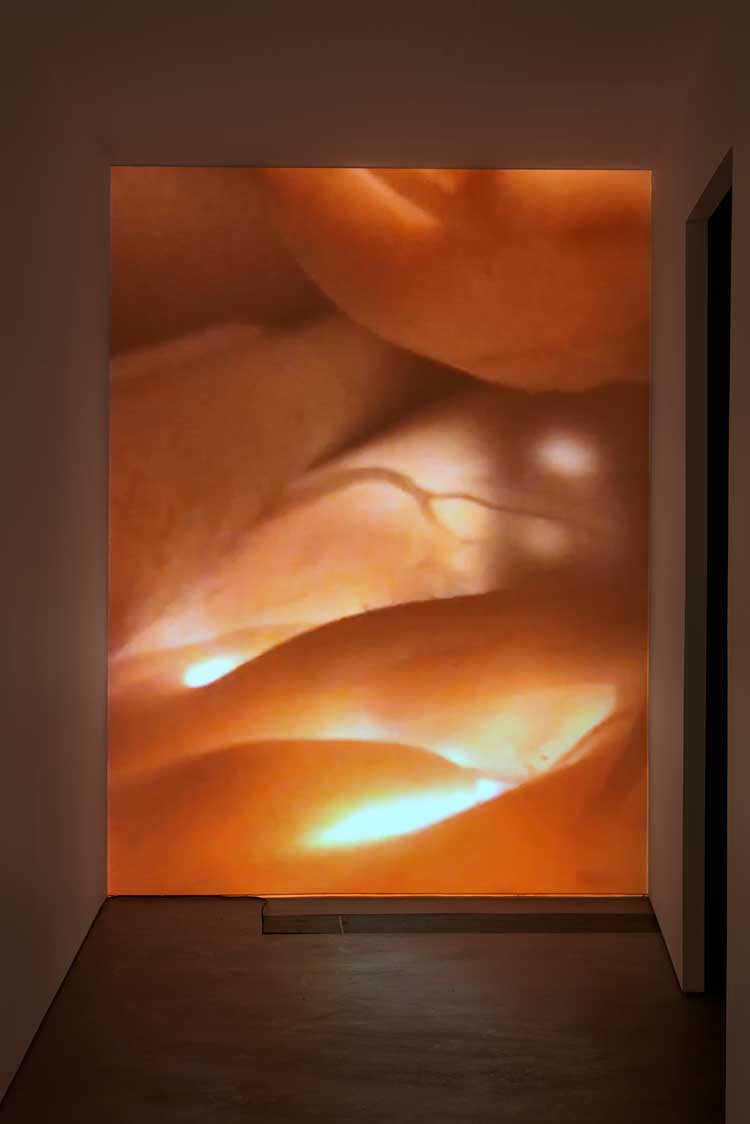
Ingela Ihrman, Green Paradise, 2009. Installation view, Nocturne, Gasworks, London, 2023. Photo: Andy Keate.
Although Lindblad’s life and spirit inform this show – indeed, as this conversation reveals, they inform the 37-year-old Swedish artist’s whole practice - you don’t need any prior knowledge of Lindblad to enjoy the work. However, it helps to understand that this pioneering naturalist and film-maker was more than Sweden’s answer to David Attenborough. He enchanted Swedish TV audiences from the 1960s to the 80s, with his intrepid expeditions to what was then, for Scandinavian TV viewers, uncharted territory, including South America and the Caribbean.
There, he wrestled giant snakes and ventured into darkened caves where small, obese baby birds called oilbirds hid from human predators, who liked to use their fat for lamps (we’ll meet the oilbirds later). More than observing and framing animals and birds against lush landscapes for us to admire at a distance, accompanied by dramatic, orchestral soundtracks, as per the usual BBC nature documentary style, Lindblad immersed himself in their habitat and learned their ways. He even adopted two orphaned tiger cubs and raised them at home, and he became so adept at mimicking certain bird calls that he could communicate with them (check it out for yourself: Jan Lindblad … how to communicate with a black-throated diver).
-Photo-Andy-Keate.jpg)
Ingela Ihrman. Still from Oilbird with Nestling, 2021. Photo: Andy Keate.
Ihrman, too, likes to get up close and personal with her subjects, creating and donning costumes for performances in which she mimics the blossoming of a flower or, as in the film at the end of this show, becoming an oilbird parent, petting and feeding her obese (glove puppet) offspring. Ihrman’s introductory leaflet offers us a choice Lindblad quote: “The closer we get to nature, the more reverence in life we feel.” And for Ihrman, as for Lindblad, the attractions of nature have nothing to do with the picturesque or aesthetic: rather, it is about sensing our interconnected coexistence. Hence her choice of subject matter includes invasive weeds, intestinal flora, extinct amphibians or obese chicks that live in the dark.
-among-the-trees-Eden-Project-Pic-Veronica-Simpson.jpg)
Ingela Ihrman, First Came the Landscape, 2022. Site-specific sculpture of a skeleton, installation view, the Eden Project. Photo: Veronica Simpson.
Shortly after the Gasworks show opened, Ihrman unveiled a new outdoor work at the Eden Project, First Came the Landscape. A site-specific sculpture of a skeleton assembled from the trunk of a fallen beech tree, it will remain outdoors and be left to return to the landscape. It reprises an earlier version of the work made outside the Uppsala Konstmuseum in 2022. Two other works by Ihrman are inside the Eden Project’s art gallery, as part of the group show Super Natural, which has been extended until 1 May 2023.
Ihrman gained a BFA and MFA at Konstfack Stockholm, in 2010 and 2012 respectively. Her previous solo exhibitions include CCA Futura, Prague (2021); Cooper Gallery, University of Dundee (2018); der TANK, Institut Kunst, Basel (2017); and Tensta Konsthall, Stockholm (2016). Group exhibitions include the Wellcome Collection, London (2021); Moderna Museet, Malmö; Kiasma, Helsinki (both 2020); Castello di Rivoli, Turin (2019); Lunds Konsthall (2018); Art Lab, Gnesta (2016). She has participated in the Yokohama Triennale (2020); Nordic Pavilion, 58th Venice Biennale (2019); and 11th Gwangju Biennale, The Eighth Climate (2016). In 2019, Ihrman was a recipient of the Pernod Ricard Fellowship.
Ingela spoke to Studio International at the Gasworks, just after the opening of her show.
Veronica Simpson: How did the idea for this film of Lindblad being consumed by a snake arise? How did you find your way into giving us that perspective of the animal and the human?
Ingela Ihrman: There was a book on my mother’s bookshelf by the Swedish naturalist Jan Lindblad, and it had been there since I was four years old. I remember that I had a look at it, and there were film stills from this Anaconda wrestling and I didn’t dare to even touch the page because the image was so strong. But it also had a fascination, with the snake and those things. Then, while I was studying art at university, I was home for Christmas and was looking around and saw the book. I started to read it and remembered the images, and there was something about him and the 1970s and the way he talks, the way he loved nature, as you see also in his books.
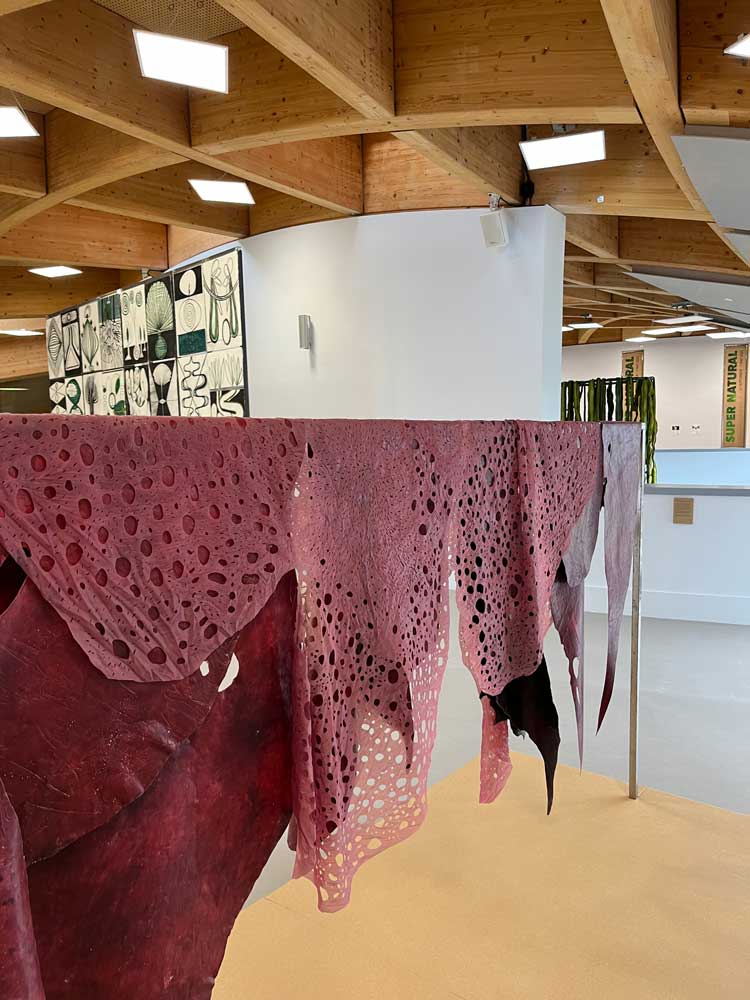
Ingela Ihrman, Sea Belt, 2019. Algae sculpture, installation view, the Eden Project. Photo: Veronica Simpson.
VS: The 1960s and 70s birthed a real era of wildlife explorers on TV, including Jacques Cousteau.
II: I think Lindblad was different in a way, maybe because he was Swedish. He was passionate, but he was not the kind of photographer who would direct his camera the way you would direct a gun to capture big cats. He was more of a storyteller. And he edited it. He did everything on his own. He was just fascinating. He could also imitate birds – as a language - because he wanted to get close, to be part of the bird’s world.
When I was in my 20s and at art school, I think I was trying to understand myself. When we were kids, my parents took me to the forest to play, and we picked mushrooms, and it was all from this love of the outdoors. They were very happy there. In a way, through Lindblad, I got to see the values that my parents had. You know the saying: you can’t see the water you swim in. Through him, I understood the 70s that they were part of. They weren’t hippies in any way, they were very middle class. But they also loved being outdoors. As a family, it meant happy moments, just next to some pond where me and my sister used to play. I think that’s why I’m struck by it. As for the Anaconda, there’s such a rich mythology around snakes and, before I’d even seen the Anaconda wrestling clip that the stills in the book were from, I made the video Green Paradise. It’s very analogue. In the sculpture studio, I made a tube out of almost wine-gum material that’s often used when you make skin … not latex. It’s more like sugar and gelatin and some pigment. I made a tube, and I squeezed a small video camera through it and then edited it together. It was just a try-out. The fascination for me was very strong to let him go deeper and deeper into this thing – and also that he was devoured as a whole. If a tiger ate someone, it would not be so good for the imagination. I could imagine him with his camera eye going deeper and deeper. The (tube) is a throat, it’s also a vagina. He wanted to be part of nature.
In Sweden, we have TV shows called One With Nature, and you literally want to be part of it – to blend in and digest. It’s also a religious moment. And maybe I’ve been using art as the things that a secular society doesn’t have space for, like the ceremonial and the existential, and what it’s like to be someone and what is death and life and love and all those things that are quite common for everyone, but I’m using my practice and these spaces to expand that.
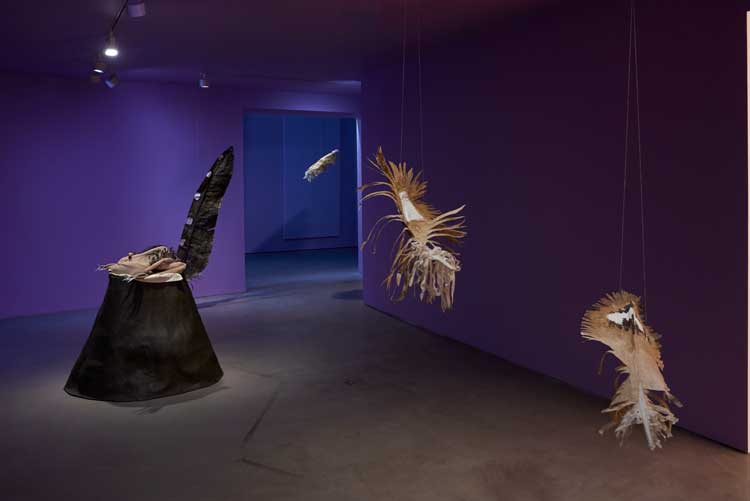
Ingela Ihrman, Nocturne. Installation view, Gasworks, London, 2023. Photo: Andy Keate.
VS: Are you trying to bring in this element of wildness to remind us of what we have lost and what we ignore as a culture?
II: Yeah, maybe. But that’s the outside look at my practice. I didn’t do it to remind someone, because, to me, it’s always there. I got it from my childhood. And Lindblad was an odd person. He had diabetes when he was young, and it wasn’t well researched and if you had it, you were regarded as odd. He was also short, like he was 160cm [5ft 3in]. He practised ballet and was a juggler. He was on the spectrum maybe. He was an outsider socially. I think he found his friends in nature and felt that was why he wanted to talk to birds, because it was like a true connection for him. He turned to where he was happy. I can relate to that. I can also relate to being mesmerised by looking at a flower or a bird. You get rid of your thoughts and your humanity by putting your mind into something else.
I think his films are made to evoke emotions. He’s emotional in his way of storytelling. His passion for his subject comes through very clearly. It’s difficult to express, but he was trying and that’s why I love him. And I think I do that, too. You want more of what you feel strongly for.
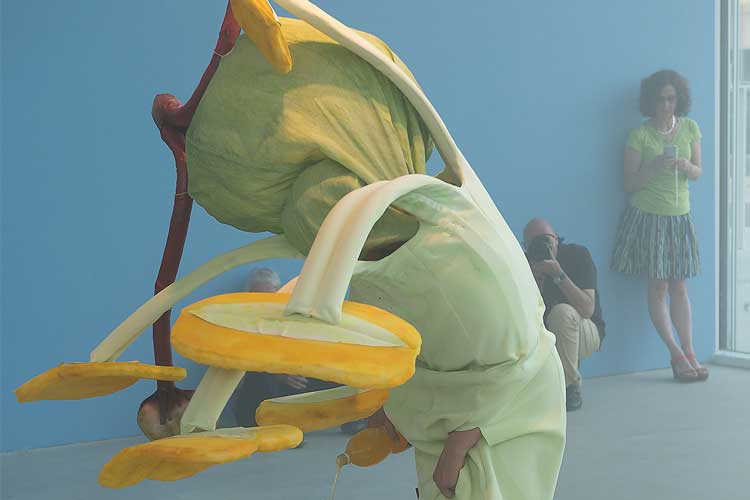
Ingela Ihrman. Costume for passionflower performance. Photo: Andy Keate.
VS: There is death as well as passion in this work. There is also a dark humour in that people might be wearing the costume of his digested remains when they view it.
II: The costume has to do with this being an exhibition and I have my ideas of how I think art makes the most meaning for people. It’s an invitation to wear it, but it’s also a way to force people into shifting their gaze, to be almost eaten by the exhibition, through play or fantasy. When people dress up in the costume, they get a spray of air freshener like a pine scent, but it comes from Lindblad’s film about the oilbird, when he talks about the smell in the cave and says it’s really strong and really doesn’t smell like pine trees in there.
VS: It’s fascinating that you are part of a growing movement of artists who are exploring our relationship to nature, to plants and animals, but when you were making that film in 2009, I don’t think that sense that this is a viable subject for art was out there.
II: Very true. I felt I was a bit on the margins and it wasn’t a topic even. I was just a weird student. We had these critical seminars in my master’s, and I thought, how am I going to contextualise this? I made a short introduction about my childhood, showing pictures of us picking berries and showing myself in the outdoors.
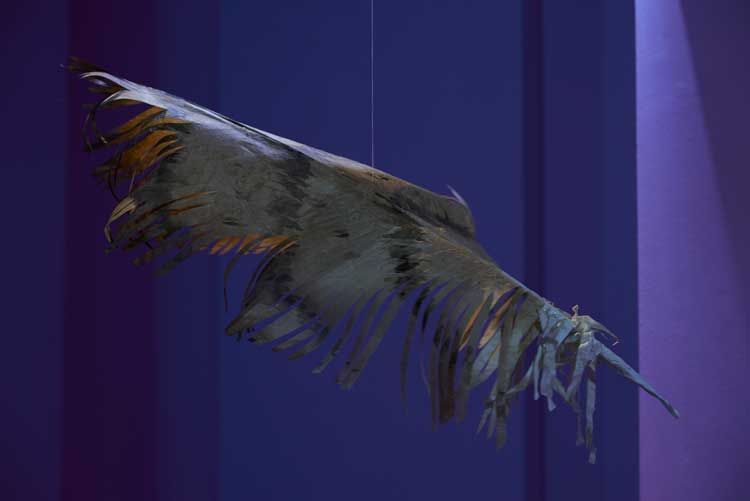
Ingela Ihrman, Feather sculpture. Installation view, Nocturne, Gasworks, London, 2023. Photo: Andy Keate.
VS: But did you have encouragement, or did you have such a strong feeling about it that you didn’t care if it felt slightly marginal; you felt it was what you had to do, that this was your subject?
II: I am grateful for my education; the teachers didn’t force me to do anything else. They were good in that sense. But I also struggled a lot. In my stronger moments, I thought: this is what young art students today are interested in. If they want to dress up like flowers, I felt my position was true and if it was true, it couldn’t be wrong. And that’s what I learned. I don’t come from this art background. To be able to work, it’s a lot of resistance all the time. I need to find my own reasons to do things, to find my bruises and push them. In recent years, my work has been used for the purposes of raising awareness, and it’s great but, in some ways, it’s also missing out on other levels of my work that are as important for me but maybe a bit neglected if you have a certain agenda, especially for group exhibitions. It’s forgiven, of course, but there’s more.
VS: What do you think is being overlooked in order to grab at what might be seen as more fashionable?
II: For me, it’s never about plants and animals. I’m not projecting things on to them. The fact that I’m inside the subject, it’s more that I need that to understand myself, but in a larger context. Maybe that’s what we mean when we say we need each other. I hear it a lot, the word care, or love. To care for things, to not be ironic. It’s a fragile position, when you say this is what I care about, not to make poses or project yourself. I also want to communicate my projects with a few lines, to open them up. I try to invite people in.
VS: You don’t want to project a mystique around what you’re doing.
II: Exactly. The world is magic enough. And, maybe, I think my presence has to be visible, I want to show that I care by having my hand, my hand has made the sculptural feathers as well. I didn’t commission them. It’s a way for me to say: take your time to watch it. I care for this, that’s why I think maybe you should care for it.
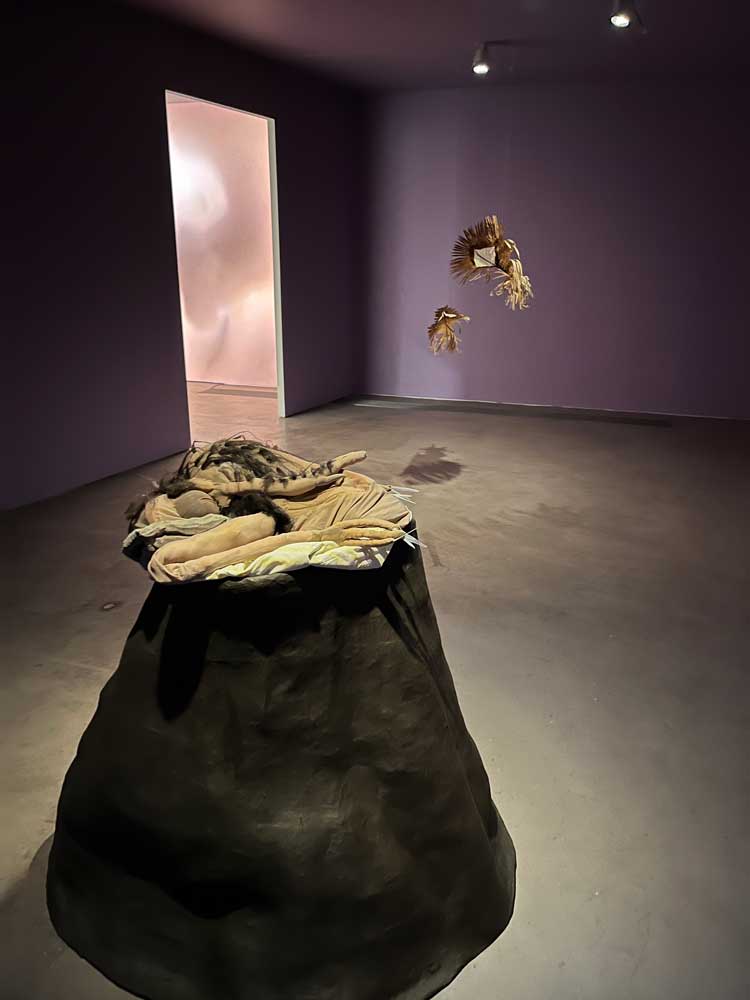
Ingela Ihrman, Oilbird cave with 'nestling' glove puppet on plinth. Installation view, Nocturne, Gasworks, London, 2023. Photo: Veronica Simpson.
VS: The video about the oilbird made me smile. There is tenderness when you, as a parent bird, are cradling the oilbird chick as it’s throwing up, and there’s humour in it as well, as you shove larger and more unwieldy pieces of fruit into its gaping beak.
II: I think, on one level, there’s this care for the baby. I don’t have children, but a lot of my friends do and my sister has kids, and I feel equal envy and horror for this parenting. There’s violence - to just throw this food into the throat. There’s something about it like playing with dolls. There’s a strong thing to have this big bird on my arm. It felt very natural.
-Detail-(feet)-Eden-Project-Pic-Veronica-Simpson.jpg)
Ingela Ihrman, First Came the Landscape, 2022. Site-specific sculpture of a skeleton, installation view, the Eden Project. Photo: Veronica Simpson.
VS: Tell me about inspiration for the Eden Project sculpture.
II: It came last summer. I was invited to do something for a summer exhibition in a city north of Stockholm. I was already at the site. It was part of a performance festival. To be honest, these outdoor summer exhibitions can be problematic: you can bring a lot of stuff outdoors to endure being rained on, but then you need to take care of it. It felt like such a bad use of resources. But I had made a smaller skeleton just with sticks before, and there were elm trees there, which are slowly dying from Dutch elm disease. There were dying trees just next to the museum, and I found a wonderful site for it, under foliage. And I got help from tree surgeons to cut it and I laid it out, and it felt so good to just use something that was already there, to rearrange it and create another meaning and leave it. I’m kind of proud of that gesture. What the skeleton means, I’m not sure, but it kind of tickles something for me. It’s next to a hospital and I think that made a reference there. If it’s in a forest, it may be more connected to the forest ecology and decomposing there.
VS: We are so much more at ease with the idea of decomposing and renewal in nature than we are with ourselves. Yet to deny it creates so much stress.
II: I think also it’s a way for me to deal with that. I feel strongly that, up until now, I haven’t even considered death. I have felt immortal. I’ve been making a lot of beginnings and now death is interesting for me again now. It’s a way to try and accept it maybe. The (Eden project) sculpture is titled First Came the Landscape. And for me that’s a comforting thought.
Detail-(hands)-Eden-Project-Pic-Veronica-Simpson.jpg)
Ingela Ihrman, First Came the Landscape, 2022. Site-specific sculpture of a skeleton, installation view, the Eden Project. Photo: Veronica Simpson.
VS: Being placed in the outdoors, it will evolve through the seasons over the year?
II: It will stay there, and the pieces of wood will not be anchored in any way. I think they will maintain it from the Eden side and maybe put things back, but after six months just leave it. Hannah [Hooks], the curator, spoke about fragility. That’s a good word, too. The work is fragile: it’s not nailed, it’s soft. And we as life forms are fragile, and the forest as an ecosystem is fragile. So, even though it’s massive, I think it’s humble. The wood is from a beech tree that came down in a storm. That was important. You wouldn’t want to have cut it down.
VS: What other things have you got lined up for this year?
II: I’m excited about a solo show in my home town of Malmö in the Konsthall, which is I think is the most beautiful building. It is opening in September.
VS: We haven’t really talked about performance, which is also part of your practice. What is the role of performance in what you do?
II: For me, it’s a social situation. I’m interested in the social aspect, and I have made many works where I have dressed up as creatures, animals and plants, and that is a coping strategy, I think. Part of me is a shy girl who doesn’t dare to speak in front of people or have a say in a group. Performance is a way for me to be visible and invisible, to be the centre of attention and perform these things, like actions - a blooming or a birth. A lot of things happen for me when I do this. It’s a challenge. It is also inviting chaos, the unexpected. Anything can happen. My costumes can break.
VS: And people respond to you in ways you don’t expect.
II Yes, and that’s also life. I think. It mirrors the uncertainty of it, those aspects of being alive that I want to share.
VS: Finally, having felt that your work placed you out on the margins, it must be nice to feel now that there is this audience, this interest.
II: Yes – I am really, really grateful.
VS: But is it a viable existence? Your work is still very much outside the commercial art scene.
II: Yes. I don’t think I could do anything else. I would find my own reasons, and they don’t need to coincide with art markets. The art world is so weird, and while trying to establish myself it’s not easy to choose where to go. It’s like you’re floating around. But I’m lucky to be in these kinds of spaces.
• Ingela Ihrman: Nocturne is at Gasworks, London, until 30 April 2023. Three Lindblad films, Anaconda Wrestling, Birds in Eternal Darkness and The Rainforests of Trinidad (all 1966), will be screened each Sunday for the show’s duration; First Came the Landscape is at the Eden Project, Cornwall, throughout 2023.